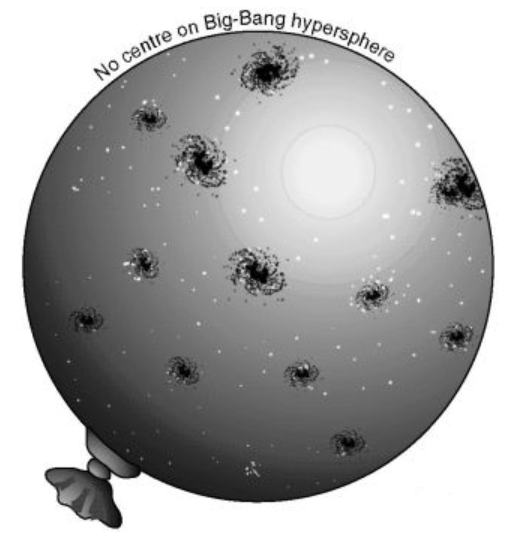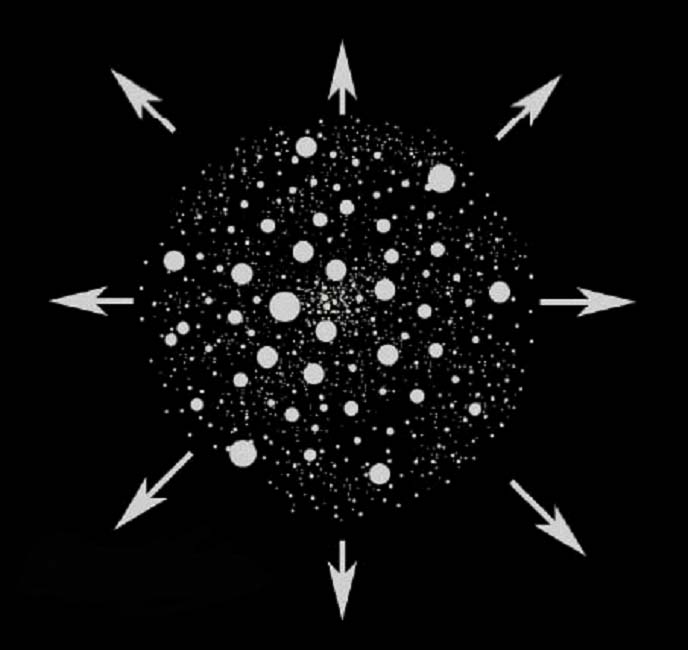
Historically the Universe was once believed to be finite. Finite means its volume is a finite number. Also the biblical view is and was that the Universe was created approximately some 4000 years before the birth of Christ. Psalms 147:4 declares,
He [God] tells the number of the stars; He [God] calls them all by their names.
Psalms 147:4 KJVER
To ‘tell’ means to count and therefore the implication is that the Universe contains a fixed or finite number of stars and hence of galaxies. Only God is infinite (Ps 147:5) but His created Universe is finite and even bounded. That means it has a centre and an edge.
The view was not universally held though. Hindu texts seemed to indicate an eternal, albeit a cyclical universe and infinite in size. But our modern scientific understanding of the Universe has developed from Christian/Biblical beliefs. Within that framework, until essentially the beginning of the 20th century it was accepted the Universe was like a ball of stars around our planet Earth.
Only with Edwin Hubble’s observations did this notion change, as he settled the big debate of the 1920’s, showing in 1929 that the Universe contained many galaxies like our own. Secondly, by observations of redshifts of galaxies and their distances, he discovered that the Universe is expanding, for which he would have won the Nobel Prize, but the selection committee followed the rules established by Nobel (who disliked astronomers) and would not award it to him. He died before they changed the rules. Nevertheless Hubble himself even questioned his own conclusion over the decades following his “discovery.”
I would note here that Lemaître published before Hubble, in 1927, wherein Lemaître developed the now famous relation, the Hubble law–later named after Hubble–but also Lemaître fitted to actual observational data, though his data were a bit poorer quality than Hubble’s in 1929.
But then until the mid 1960’s, the dominant cosmological belief for the Universe, was the Steady State (SS) cosmology. It held to an eternal (non-cyclical) universe, which was infinite and unbounded. With Hubble’s discovery of an expanding universe and then the discovery of the Cosmic Microwave background radiation (1965) Hoyle and Geoffrey Burbidge modified (1993) their SS model to incorporate cyclical periods of expansion and collapse, yet still an eternal universe–called the Quasi Steady State Creation (QSSC) cosmology.
From the earliest development of the modern standard big bang cosmology, the Friedmann-Lemaître model for the Universe began in time in a cosmic fireball. It was mostly believed to be finite in size, but not bounded. This means in that model the universe has no centre and no edge. Like the surface of balloon. This is standard in many cosmology textbooks. Of course the Universe is 3 dimensional (3D) and the surface of the balloon shown here is a 2-dimensional (2D) analogue representing the real Universe. Then since 1998, with the discovery that the expanding Universe was also accelerating, it has been believed that the Universe is infinite in size and unbounded.
In 2013 I published a paper in the International Journal of Theoretical Physics titled “A valid finite bounded expanding Carmelian universe without dark matter” (Int. J. Theor Phys (2013) 52:4360–4366). In that paper I show a solution of Einstein’s field equations in Carmeli‘s Cosmological General Relativity (CGR), where our galaxy is at or cosmologically near the center of a finite yet bounded spherically symmetrical isotropic universe. The new solution though is identical with the unbounded solution. Here is a preprint of the paper.

I show that this leads to the conclusion that the Universe may be viewed as a finite expanding “white hole.” This is not the white hole solution of Einstein’s spacetime but has similarities to it. The fact that CGR has been successful in describing the distance versus redshift data of the high-redshift type Ia supernovae means that the data cannot be used to distinguish between unbounded models and those with finite bounded radii of at least c/H0 (ie. the speed of light divided by the Hubble constant, which is the distance scale of the Universe).
According to Carmelian theory, whether or not the Universe is finite bounded or unbounded it is spatially flat (ie. has Euclidean geometry) at all epochs where it was matter dominated. As a consequence in a finite bounded universe no gravitational redshift in the light from distant source galaxies would be observed. This describes the Universe we see with our telescopes. Therefore the new solution I found describes an expanding “white hole” with the observer at the origin of the coordinates, the unique center of the Universe, ie. our galaxy is somewhere near the centre, cosmologically speaking. Only philosophically can this solution be rejected.
Cosmologist George Ellis,
People need to be aware that there is a range of models that could explain the observations. For instance, I can construct you a spherically symmetrical universe with Earth at its center, and you cannot disprove it based on observations… you can only exclude it on philosophical grounds.
In my view there is absolutely nothing wrong in that. What I want to bring into the open is the fact that we are using philosophical criteria in choosing our models. A lot of cosmology tries to hide that.
Gibbs, W.W.: Profile: George F.R. Ellis: Thinking globally, acting universally. Sci. Am. 273(4), 50–55 (1995)
In addition this model describes an accelerating spherically expanding universe without the need for the inclusion of dark matter. And the observational data cannot be used to exclude models that are finite in extension. This brings us back to that simple notion mankind once believed derived from a straight-forward reading of the biblical text. Our place in the Universe just might be special after all.
Additional Reading
- Our Galaxy Near the Centre of Concentric Spherical Shells of Galaxies?
- Hubble: Does our Galaxy occupy a special place in the Universe?
- Where I Now Stand
- My Current Thinking on Distant Starlight
- Does My Use of Carmeli’s Cosmology Provide a Valid Solution to the Starlight-Travel-Time Problem?
Follow me
- Telegram.org: @GideonHartnett
- Facebook: Gideon Hartnett
- X (Twitter): @gideon195203

To be notified by email put your email address in the box at the bottom of your screen. You’ll get an email each time we publish a new article.

Click this image to make a secure Donation (Stripe) !







One response to “The Universe: Finite or Infinite, Bounded or Unbounded”
That is super interesting though i cant pretend to understand it all. I must say, despite not being christian I keep bumping up against the idea that the Bible is always right. At the very least it is chock full of the most useful information. I think our society is making a huge mistake in rejecting christian beliefs. Conversely i think Christians are making a mistake in rejecting science. I think these two beliefs are more compatible than most people realise. Thanks John for the connection.
LikeLike